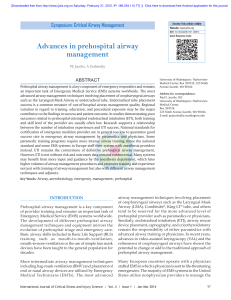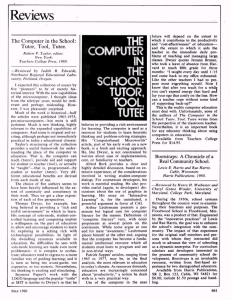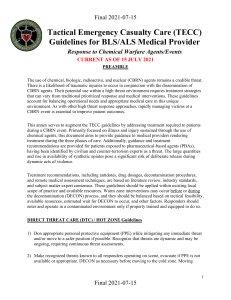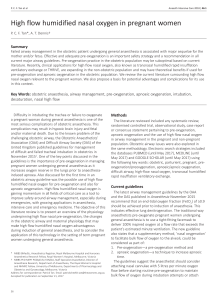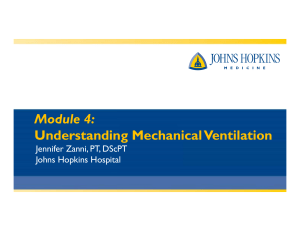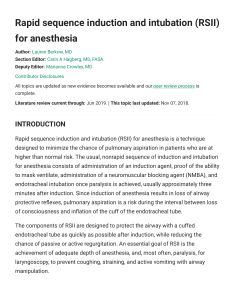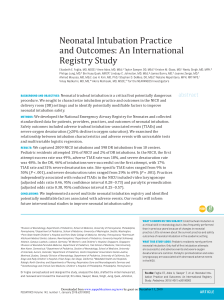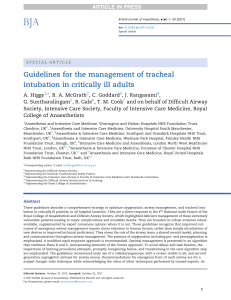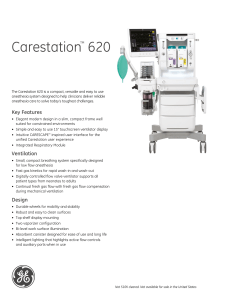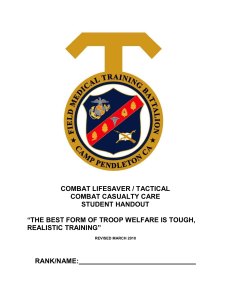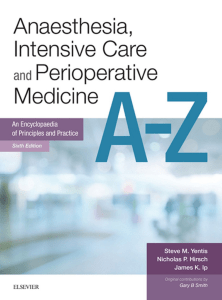A brief history of clinical airway management
Anuncio
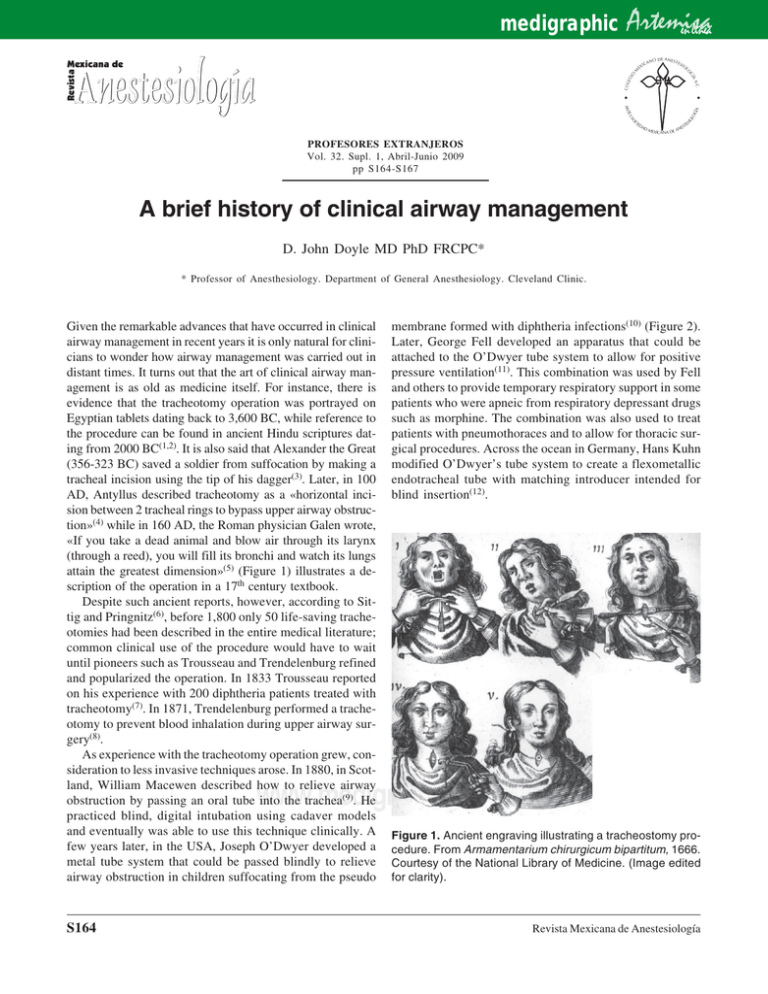
ICA T ES C IO L .C. COL E A N ES AA ES ANT SO CI ED AD NO D LO GÍA IO EX EG M GÍ Revista Mexicana de O Anestesiología Artemisa en línea IO medigraphic ES ST NE MEXI CANA DE A PROFESORES EXTRANJEROS Vol. 32. Supl. 1, Abril-Junio 2009 pp S164-S167 A brief history of clinical airway management D. John Doyle MD PhD FRCPC* * Professor of Anesthesiology. Department of General Anesthesiology. Cleveland Clinic. Given the remarkable advances that have occurred in clinical airway management in recent years it is only natural for clinicians to wonder how airway management was carried out in distant times. It turns out that the art of clinical airway management is as old as medicine itself. For instance, there is evidence that the tracheotomy operation was portrayed on Egyptian tablets dating back to 3,600 BC, while reference to the procedure can be found in ancient Hindu scriptures dating from 2000 BC(1,2). It is also said that Alexander the Great (356-323 BC) saved a soldier from suffocation by making a tracheal incision using the tip of his dagger(3). Later, in 100 AD, Antyllus described tracheotomy as a «horizontal incision between 2 tracheal rings to bypass upper airway obstruction»(4) while in 160 AD, the Roman physician Galen wrote, «If you take a dead animal and blow air through its larynx (through a reed), you will fill its bronchi and watch its lungs attain the greatest dimension»(5) (Figure 1) illustrates a description of the operation in a 17th century textbook. Despite such ancient reports, however, according to Sittig and Pringnitz(6), before 1,800 only 50 life-saving tracheotomies had been described in the entire medical literature; common clinical use of the procedure would have to wait until pioneers such as Trousseau and Trendelenburg refined and popularized the operation. In 1833 Trousseau reported on his experience with 200 diphtheria patients treated with tracheotomy(7). In 1871, Trendelenburg performed a tracheotomy to prevent blood inhalation during upper airway surgery(8). As experience with the tracheotomy operation grew, consideration to less invasive techniques arose. In 1880, in Scotland, William Macewen described how to relieve airway obstruction by passing an oral tube into the trachea(9). He practiced blind, digital intubation using cadaver models and eventually was able to use this technique clinically. A few years later, in the USA, Joseph O’Dwyer developed a metal tube system that could be passed blindly to relieve airway obstruction in children suffocating from the pseudo membrane formed with diphtheria infections(10) (Figure 2). Later, George Fell developed an apparatus that could be attached to the O’Dwyer tube system to allow for positive pressure ventilation(11). This combination was used by Fell and others to provide temporary respiratory support in some patients who were apneic from respiratory depressant drugs such as morphine. The combination was also used to treat patients with pneumothoraces and to allow for thoracic surgical procedures. Across the ocean in Germany, Hans Kuhn modified O’Dwyer’s tube system to create a flexometallic endotracheal tube with matching introducer intended for blind insertion(12). www.medigraphic.com S164 Figure 1. Ancient engraving illustrating a tracheostomy procedure. From Armamentarium chirurgicum bipartitum, 1666. Courtesy of the National Library of Medicine. (Image edited for clarity). Revista Mexicana de Anestesiología Doyle DJ. A brief history of clinical airway management Figure 2. Dr. Joseph O’Dwyer’s glottic tube system. This was used primarily in the late 1800s to maintain the airway in children with diphtheria. The device was placed blindly and required that the operator place his hand in the child’s mouth to introduce the device. Occasionally, the child would bite the operator, infecting him. Image Credit: http://www.case.edu/artsci/dittrick/site2/museum/artifacts/ group-b/b-3intubation.htm (Of interest, O’Dwyer lived to see his life-saving airway equipment rendered into a largely historic relic as antitoxin research by von Behring and others provided a much-needed remedy for diphtheria in 1890. Immunization against diphtheria began several years later. The first ever Nobel Prize for Medicine or Physiology was awarded to von Behring in 1901 for his ground-breaking work). One important problem with the O’Dwyer intubation system and its variants was that they had to be placed blindly. The next important development in clinical airway management was thus the development of direct laryngoscopy, which allowed visualization of the glottic structures. Manual Garcia (1805-1906), a professor of singing in London, England is commonly credited with the discovery of laryngoscopy. In 1855, he described how he could perform «autolaryngoscopy» through the use of a dental mirror in combination with a second, larger mirror used to direct sunlight into his mouth(13). This arrangement allowed him to see his larynx and trachea, a feat fortuitously made possible because of his absent gag reflex. Earlier, as a mere medical student, Benjamin Guy Babington created a «glottiscope» in 1829(14). Unfortunately, the invention did not have the impact it deserved. A number of years later, towards the end of the 19th century, Kirstein developed an instrument he called an «autoscope» (Figure 3)(15). The idea for this instrument came to Kirstein after he learned how an endoscope intended for esophagoscopy had inadvertently slipped into the trachea. His Figure 3. Line engraving of Kirstein performing laryngoscopy with his laryngoscope. From Hirsh et al. (1986). design was subsequently modified by Jackson by providing distal illumination with a tungsten light bulb and other modifications. The 1940s saw the development of the Miller and MacIntosh laryngoscopes in common clinical use today. In 1941, Robert Miller described his straight laryngoscope blade(16), while in 1943 Robert MacIntosh described his curved blade(17). (MacIntosh hoped that by minimizing contact with the epiglottis, that his laryngoscope would be less stimulating). At the same time, in Montreal, Canada in 1942, Harold Griffith introduced curare as a muscle relaxant with a view to facilitating abdominal surgery and other procedures(18). As a result, tracheal intubation became routine in major surgical procedures. Although 60 years later variations of the MacIntosh and Miller laryngoscopes are still in common use, because both occasionally fail to provide adequate glottic views, efforts to improve on their designs have continued. The result has been a continuing series of innovations in laryngoscope design, including developments such as fiberoptic bronchoscopes optimized for intubation, the Bullard laryngoscope and its variants, the McCoy articulating laryngoscope, various optical stylettes, and video laryngoscopes such as the GlideScope and the McGrath video laryngoscope. Finally, any history of airway management would be incomplete without mentioning supraglottic airway devices such as the Laryngeal Mask Airway (LMA). As figure 4 illustrates, Dr. Archie Brain, the inventor of the LMA, went www.medigraphic.com Volumen 32, Suplemento 1, abril-junio 2009 S165 Doyle DJ. A brief history of clinical airway management Figure 4. Early prototypes of the laryngeal mask airway. Image Courtesy Dr. Archie Brain. Figure 6. The Deathbed of George Washington. In December 1799 George Washington developed a nasty sore throat accompanied by fever, swelling, and difficulty swallowing. He was diagnosed with an «inflammatory quinsy». Although one ofDOCUMENTO his physicians,ES Elisha Cullen Dick, proposed perforESTE ELABORADO POR MEDIGRAming a tracheotomy to aid in Washington’s breathing, this PHIC suggestion was rejected by the other physicians. Instead, Washington was repeatedly phlebotomized (to a total of five pints of blood!). This therapy undoubtably contributed to his death. Image Credit: http://www.britannica.com/eb/art-56168. Figure 5. Leech’s pharyngeal bulb gasway, 1937. A description of Dr. Leech and his invention is available at http:// www.cja-jca.org/cgi/reprint/37/6/689.pdf thorough a considerable variety of prototype designs before the clinical launch of the LMA in the 1980s. Many people are unaware, however, that other supraglottic airway (Figure 5) were in clinical use long before the invention of LMA, although these devices were eventually eclipsed by the popularization of tracheal intubation following the popularization of curare. Table I. Some landmarks in clinical airway management. Biblical Times Death from airway obstruction recognized (trauma, strangulation, leprosy, abscesses) 1700s 1842 1854 1878 1885 1895 1900 World War I 1920 1920s 1942 Metal and leather tubes inserted blindly into the trachea for treatment of drowning Crawford Long discovers ether anesthesia Garcia, a professor of singing, develops indirect laryngoscopy Chloroform administered through tracheal tube (MacEwen) O’Dwyer popularizes intubation for diphtheria Kirstein develops direct laryngoscopy Kuhn develops a flexometallic tracheal tube Many casualties requiring head and neck surgery adds impetus to widespread use of intubation in military hospitals; Magill introduces tracheal tube with inflatable cuff Chevalier Jackson designs improved laryngoscope Magill develops blind nasal intubation Griffiths introduces curare into clinical practice S166 Revista Mexicana de Anestesiología www.medigraphic.com Doyle DJ. A brief history of clinical airway management Continuous Table I. Some landmarks in clinical airway management. 1946 1950s 1960s 1962 1940s-1970s 1970s 1980s 1990s 1995 2000s Mendelson describes aspiration pneumonitis Popularization of the use of tracheal tubes for general anesthesia Advent of electronic patient monitoring Sellick maneuver and rapid-sequence induction developed Continuing improvements in laryngoscope and tube designs; use of plastic Development of implant-tested low-irritation, low-cuff pressure disposable tracheal tubes Popularization of fiberoptic intubation. Introduction of pulse oximetry and capnography as noninvasive means of assessing oxygenation and ventilation. Popularization of laryngeal mask airway, rigid fiberoptic laryngoscopes (Bullard, Wu, etc.,) and ASA Practice Guidelines for Management of the Difficult Airway. Increased awareness of the special challenges of the «difficult extubation» patient. Founding of the Society for Airway Management (www.samhq.com) Introduction of video laryngoscopes (GlideScope, McGrath, etc.) REFERENCES 1. 2. 3. 4. 5. 6. 7. 8. Pahor AL. Ear, nose and throat in Ancient Egypt. Journal of Laryngology and Otology 1992;106:773-779. Stock CR. What is past is prologue: A short history of the development of the tracheostomy. Ear, Nose and Throat Journal 1987;66:166-169. Szmuk P, Ezri T, Evron S, Roth Y, Katz J. A brief history of tracheostomy and tracheal intubation, from the Bronze Age to the Space Age. Intensive Care Med 2008;34:222-228. Ferlito, Alfio. Percutaneous Tracheotomy. Acta Oto-Laryngologica 2003;123:1008-12. Stoller JK. The history of intubation, tracheotomy and airway appliances. Respiratory Care Volume 1999;44:595-603. Sittig E, Pringnitz JE. Tracheostomy: Evolution of an Airway. AARC Times 2001. Ezri T, Evron S, Hadad H, Roth Y. Tracheostomy and endotracheal intubation: a short history. Harefuah 2005;144:891-3, 908. Keys TE. The history of surgical anesthesia. New York, Dover Publications, 1963. 9. 10. 11. 12. 13. 14. 15. 16. 17. 18. Macewen W. Introduction of tracheal tubes by the mouth instead of performing tracheotomy or laryngotomy. Br Med J 1880;II:122–4. Westhorpe R. O’Dwyer’s tubes. Anaesth Intensive Care 1991;19:157. Fell SC. A history of pneumonectomy. Chest Surg Clin N Am 1999;9:267-90. Thierbach A. Franz Kuhn, his contribution to anaesthesia and emergency medicine. Resuscitation 2001;48:193-7. Alberti PW. The history of laryngology: a centennial celebration. Otolaryngol Head Neck Surg 1996;114:345-54. Harrison D. Benjamin Guy Babington and his mirror. J Laryngol Otol 1998;112:235-42. Hirsch NP, Smith GB, Hirsch PO. Alfred Kirstein. Pioneer of direct laryngoscopy. Anaesthesia 1986;41:42-5. Miller RA. A new laryngoscope. Anesthesiology 1941;2:317–320. Macintosh RR. A new laryngoscope. Lancet 1943;1:205. Griffith HR, Johnson GE. The use of curare in general anaesthesia. Anesthesiology 1942;3:418-20. www.medigraphic.com Volumen 32, Suplemento 1, abril-junio 2009 S167
